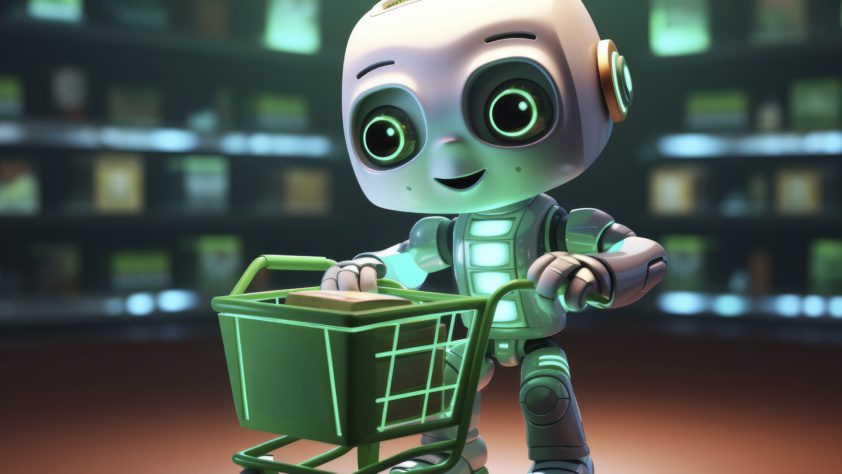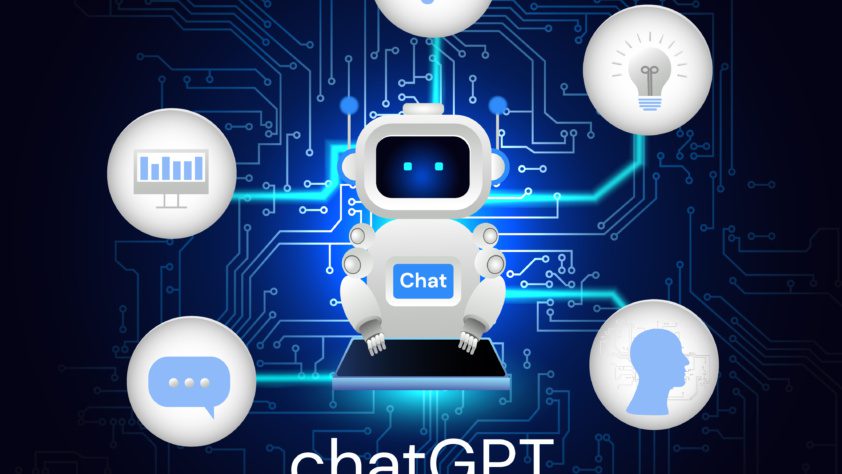Artificial intelligence is developing rapidly today and is gradually becoming a key part of web development – from writing code to creating visuals. Experts have many opinions on the further development of artificial intelligence. Some experts claim that in 5-10 years artificial intelligence will learn to write code, that programmers will simply not be needed. Others claim that AI will completely replace programmers in 50-100 years. However, today, artificial intelligence only helps in web development, it cannot completely replace it at the moment, but it helps.
The work of artificial intelligence has also actively begun to spread to the use of voice acting, as this solution is considered faster and cheaper than hiring a live actor to voice an application or video game. However, AI is also famous for its controversy due to the possible use of someone else’s intellectual property, as well as the deprivation of the work of actors, whose employment is often unstable due to high competition.
But should you pay attention to this new feature, like AI voiceover, and what does it offer to companies that use it? Before making a decision, we suggest you take a closer look at the technology, how it is created, and what benefits and challenges AI voiceover presents.
AI Voiceover Explained: How AI Text-to-Speech and Voice Generators Work
AI voice acting is a voiceover technology that uses a machine learning model to reproduce a voice and/or convert text into an audio file. Text-to-speech (TTS) technology, it is a simpler technology and uses a computer-generated voice. Such machine-generated voice acting is a cheaper solution, but not very high-quality, since the generated voice sounds soulless, boring and monotonous. But TTS can be useful for voice commands and concise instructions within the application, for example.
Another option is to use an AI voice generator based on a real human voice. Such generators are trained on the human voice and provide the most realistic voice possible, with more authentic emotions, intonations and pronunciation. Also, human-based AI voiceover offers a variety of voices (both male and female), languages, accents, etc. It can use the voice of a famous person and change their language so that they speak a foreign language as if it were their native language. This type of voiceover is most often used for online books, video games, audio and video content for education, etc.
The most famous examples of AI voiceover tools are Murf.ai, Google Text-to-Speech, Amazon Polly, and others.
Key Industries Leveraging Artificial Intelligence Voice Technology
AI voiceover and text-to-audio are currently being used in areas such as:
- E-learning. Textbooks, audio and video tutorials provide a personalized learning experience and simplify the delivery of necessary information to the student.
- Audiobooks. AI voiceover is gradually gaining momentum due to its accessibility and low cost. Instead of spending time and money on hiring a live actor and scheduling a voiceover, you can use a voice sample and have it dubbed using a machine learning model.
- Virtual assistants and voice interfaces. AI voiceover is also gaining momentum in the field of chatbots and assistants like Siri, Alexa, Google Assistant, etc. As with audiobooks, using AI to voice virtual assistants is a quick and cheap solution.
- Video games. Thanks to the variety of voices, emotions and accents, developers can choose the desired voice for a game character or NPC, which will advantageously emphasize their character and personality.
- Marketing and creation of advertising content. It was proven that the voice use in advertising has a positive effect on audience engagement and on the perception of information. Therefore, for greater accessibility to materials, AI voice-over has gradually begun to be used.
How to Create Studio-Quality Voiceovers
To provide voiceover using artificial intelligence, you need to take a few basic steps. First, you need to choose the right tool that meets your initial goal (whether it is a large-scale audiobook voiceover or a voice for a chatbot.) Second, you should write a script of the text that your artificial voice will read.
Next, you select the voice sample that you want to use for the program. This also includes choosing the language, as well as setting the desired emotion, tone, and accents. When choosing a voice, you need to clearly make sure that the owner of the voice has given explicit permission for the artificial intelligence to use it.
The next step is the initial generation of the AI audio track. Depending on the tool, you need to click on the buttons one or more times to generate and listen to the material. Next, additional editing of nuances in intonation and accents is carried out and additional generation is carried out until the user gets a result that he is satisfied with.
Turning Text into Speech: Our Experience with Book Voiceovers
Although TuneLab had no direct experience with using artificial intelligence for voiceover, we had plans to use AI to sort live voiceovers for books. One of these experiences was working on books in Chinese 1-2-tree.
The customer wanted a student to open the book and start the voiceover. That is, when hovering over and highlighting each word or character, the announcer would pronounce it and the student would see where he was reading. The main difficulty in the project development was precisely to synchronize the translation with how the system highlights. How was this done?
The customer company provided us with audio files with voiceovers and Chinese textbooks in PDF format for work. Our task was to convert the book from PDF to HTML, and on the website we can work with this text.
As for working with audio, another task was to cut the pronounced characters and clearly define the timecodes. Therefore, we took these audio files, parsed and analyzed them, and put tags using a recognition module that fixes pauses between words. We could set the time of this pause so that this tag could be put. Thus, we marked these pauses on the audio track and could form a kind of scheme of the audio track, where on this scheme we saw the words. We fixed the start and end time of the pronunciation of the word by the speaker on the audio track. And, thus, we split this track.
Such functionality was implemented using the custom logic that we wrote. Several services do this, they were paid and they only support the English language. However, there was no such solution on the Internet that would work with Chinese, so this functionality had to be developed independently.
Our Strategy for Voice AI Integration
The original model of processing and entering a book into the site library along with the voiceover was done manually. Initially, while the book was being parsed, a page with several hieroglyphs would be displayed. A teacher clicks on the hieroglyph, then on the drop-down window, selects a chosen audio fragment in order to listen to it. Next, he assigns a certain time interval to the hieroglyph and moves on to the next hieroglyphs. But this solution takes a lot of time, and is too long and monotonous for a person.
Therefore, we’d apply a second solution that would optimize the definition of intervals. The system, using artificial intelligence, would assign a interval to each hieroglyph automatically. This was much easier, because 90% had already been assigned. The person would have to check the errors made by the AI, which would have made unnecessary intervals in one word or combined two words into one. But, since a machine learning model would be introduced into the work, with each book the AI would do its job more and more accurately.
The Benefits of Using AI for Voice Generation
AI voiceover brings a considerable number of advantages for companies that need to develop their product. In particular, we can mention the following
- Saving time and money. Artificial intelligence has long established itself as a fast and cheap solution for high-quality voice acting. First of all, costs are reduced due to the fact that there is no need to hire a separate live actor, assign time for dubbing and pay for the work performed. It is enough to go to the voice database or use your own voice sample and generate the desired audio file.
- The ability to create voices of any language. AI voiceover tools have a number of languages that an artificial voice can speak. Or you can make the voice of a famous person start speaking in another language. In addition, there is an opportunity to create different accents and intonations.
- Adaptability to different platforms and formats. Artificial intelligence in voiceover has wide application not only in the field of web development, but also in the field of entertainment media as such – from audiobooks to voice acting in films. One of the bright examples of the use of artificial intelligence in dubbing was the film “The Brutalist”. In it, the main characters played by Adrien Brody and Felicity Jones spoke with a Hungarian accent precisely with the help of artificial intelligence – the actors themselves did not even have to rehearse and learn the language to accurately convey their characters.
Risks and Ethical Concerns of Artificial Intelligence Voice Technology
Despite the speed and ease of use of AI voiceover, it still has certain drawbacks. First, the machine that voices the audiobook may not always clearly pronounce the necessary words and phrases. However, the machine learning model is improving pronunciation and correct accents every time.
In addition, some users note that audiobooks voiced by artificial intelligence sometimes do not have the same soulfulness and character that books voiced by a living voice usually have. First of all, this is influenced by the above-mentioned errors in pronunciation and accents that the machine learning model can allow.
Last but not least, when choosing voiceover using artificial intelligence, it is imperative to pay attention to the ethical aspects of using voice cloning. Like any product created by generative AI, voiceover may contain recycled content that may be protected by copyright. So, when using a live human voice sample for an application, you need to make sure that you have received explicit consent to use the human voice, or that the voice sample used for voiceover has confirmed permission to use it.
Thanks to artificial intelligence, creating high-quality voiceovers has become accessible, fast and cost-effective. From audiobooks to voice chatbots and video games, AI voice generators are opening up new opportunities for various fields.
When choosing the best tool for your needs, it is important to determine key criteria: the purpose of use, the quality of the synthesized voice, different languages support, the ability to adjust intonation and timbre, and the availability of free or paid features.
If you are planning to implement AI voiceover in your project, pay attention to testing different services before choosing, take into account the specifics of your audience and use the latest technologies to make content more attractive and effective. AI voice is a tool that can significantly improve the quality of interaction with users and help you reach a new level in creating audio content.
Keywords: artificial intelligence voice, voice ai, voice over, voice over voices, voiceover voices, free ai voice generator, ai text to speech, free voice converter, ai voice generator free, text to speech ai, ai voice over, best ai voice generator, voice generator, best ai text to voice, vocal generator , voice gen, narration generator, ai voiceover, ai speech generator, ai voice text to speech, vocal maker, ai text to voice, text to voice over generator, voice to speech generator, text to speech generation, artificial intelligence voice, voice artificial intelligence, artificial intelligence voice cloning, artificial intelligence voice chat, artificial intelligence voice to text, artificial intelligence voice recognition, voice recognition artificial intelligence, artificial intelligence voice assistant, google voice artificial intelligence



